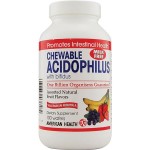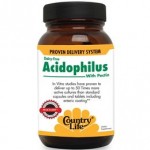If one knows the difference between the words “anti-biotic” and “pro-biotic,” then the immediate  need for acidophilus while taking antibiotics is made clear. An anti-biotic means “against life” while a pro-biotic means “for life.” If you take something that is against life, then you better well take a countermeasure such as a pro-biotic, i.e., acidophilus, to assure a balance.
 Where are we talking about the need for balance? In the gut. Antibiotics aren’t really very smart; they can’t distinguish between what is a “bad” bacteria and a “good” bacteria in a person’s gut.
Where are we talking about the need for balance? In the gut. Antibiotics aren’t really very smart; they can’t distinguish between what is a “bad” bacteria and a “good” bacteria in a person’s gut.
Thus they eliminate or try to eliminate all bacteria from the gut and then diarrhea or worse develops. This is not a good thing to have happen as we all need a certain amount of bacteria, good and bad, in our guts. But what we mostly need is a balance between the two.
1) How do we obtain this balance that is needed? The taking of acidophilus in sufficient amounts will assure that we won’t develop such bad things as pseudomembraneous colitis which can be deadly. Most antibiotics taken will cause in most people some form of either constipation, abdominal cramping or diarrhea because they upset the balance of flora in the gut.
 Many individuals quit taking antibiotics longterm because they develop one or all of these problems. Diarrhea is the usual one to happen after which dehydration can begin and electrolytes get out of whack and wham! A person becomes very ill.
Many individuals quit taking antibiotics longterm because they develop one or all of these problems. Diarrhea is the usual one to happen after which dehydration can begin and electrolytes get out of whack and wham! A person becomes very ill.
2) So when antibiotics are first begun, there also needs to be on hand, an acidophilus that will do an excellent job of balancing the gut. A good acidophilus is milk free, and each capsule should provide a high mixture of biointestinal cultures giving beneficial effects on the function of the human digestive tract. The cultures should also provide effective cofactors in support of protocols for yeast infections (including vaginitis), thrush and cold sores.
The best acidophilus should also say on its bottle that it needs to be refrigerated on opening to help assure potency. It should also contain FructoOligoSaccharides (FOS), because it is a substance which enhances the growth of “good” bacteria and of course should contain no fillers or additives. It should also contain 7-8 different strains of good bacteria adding up to billions of organisms per capsule. This gives an extra plus in keeping the gut flora in balance. For IC patients, especially, the acidophilus should be in a hypoallergenic media enclosed within a formaldehyde-and-preservative-free gelatin and glycerin capsules The acidophilus should also survive stomach acids and readily implant in the intestines.
3) How much acidophilus is needed to keep the gut flora in balance?
That amount is usually different for each individual, but it’s not difficult to determine what amount is needed. Three a day is a “normal” dosage of acidophilus, but if a person finds that that dosage doesn’t stop cramping, diarrhea or constipation, then the dosage needs to go up. First, one goes to four/day, then five, and possibly six and in extreme instances of very high daily doses of antibiotics, even 12 a day may be needed.
 4) When should one take their acidophilus? NEVER with the antibiotic as they will just cancel each other out; think of the good going against the bad at the same time and there is just no contest. They cancel each other out. But if the acidophilus is taken one hour before or one hour after the antibiotic dose, the balance should be maintained.
4) When should one take their acidophilus? NEVER with the antibiotic as they will just cancel each other out; think of the good going against the bad at the same time and there is just no contest. They cancel each other out. But if the acidophilus is taken one hour before or one hour after the antibiotic dose, the balance should be maintained.
If you wish to start your day with the acidophilus, you go to the refrigerator and take your first acidophilus dose of the day just as soon as you get out of bed (well, after you have been to the bathroom the last time of the night). Then you can make your bed, take your shower, get ready for work or whatever and then an hour later, you are ready for breakfast and after eating you take the antibiotic. Most antibiotics will not then cause you stomach problems if always taken with food.
Next, an hour before lunch, take your next acidophilus, and at lunch, your next antibiotic or if you need to, take it midafternoon an hour before a good snack and the antibiotic. If you eat dinner late, you can again take the acidophilus an hour before eating and then the antibiotic. This works best if you are attempting to keep 8 hours between the taking of each dose of antibiotic and you are taking three doses a day, or you may need to take you last antibiotic dose nearer bedtime in which case again, an hour before doing so, you need to take the acidophilus.
5) Or believe it or not, you can get up first thing in the morning once you have determined how many acidophilus you need after a week or so on the antibiotic, take them all at once, and never have to think about them the rest of the day because they will be at work in your gut for you all 24 hours until you take them again the next morning. Just remember you can always adjust your acidophilus intake up or down depending on what your gut or stomach is telling you.
 If you get cramping, you may need to also increase the dosage or you may just need to eat more food when you take your antibiotic.
If you get cramping, you may need to also increase the dosage or you may just need to eat more food when you take your antibiotic.
6) Many individuals quit taking longterm antibiotics because they get into gut flora balance problems because they have not added a proper acidophilus to their routine. You don’t have to be among them. Make sure you buy a good acidophilus and take it! And always remember to take Nystatin or an antiyeast supplement AT the same time you take each antibiotic dose. By taking the two (the acidophilus and the antiyeast medication/supplement), there is very little chance of the antibiotic causing you ANY of the above-mentioned problems.
